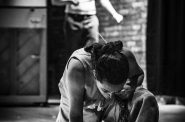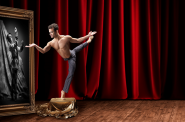Win-Win

A moment from Mauro de Candia’s “Something I Had in Mind.” Jessica Kaminisk photo for the Milwaukee Ballet.
If I were betting, my money would be on Mauro de Candia to carry the audience vote for the Milwaukee Ballet‘s Genesis International Choreography Competition, which opened Thursday at the Pabst Theater.
De Candia, an Italian ensconced in Berlin, offered plenty of reasons to favor his Something I Had in Mind, set mostly to Paganini’s antic violin Variations on The Carnival of Venice. First, he showed a rare gift for abstract dance comedy. Imagine a virtuoso version of Monty Python silly walks, just as goofy but requiring hard-body athletics. When Kara Bruzina, Valerie Harmon, Courtney Kramer, Nicole Teague, Justin Genna, Sam Neale, Joshua Reynolds and Tanner Schwarz slouched, they snapped into that sad-sack pose and held it in a taut, concave arch. And they didn’t just stand there, they darted about as fast and sharp as jackrabbits.
De Candia came up with lots of intricate partnering with limbs pointing in wrong directions. Much of the movement came in rapid staccato. The dancers rendered it with the point-to-point precision of the ticking second hand of a very good watch — the dancers gave de Candia a tremendous first performance. De Candia’s crafty relation of music and dance also amused and impressed. He sometimes focused on the impetus of the meter and other times of the gesture of the line. He cleverly matched musical ornament with witty flourishes of the limbs.
If Something I Had in Mind has a flaw, it would be that de Candia clearly had two things in mind, and they aren’t so coherent within the same piece. When the Paganini variations ended, everyone disappeared except Joshua Reynolds. Edith Piaf’s Non, Je ne regrette rien piped up, and Reynolds responded with a solo focused mainly on sinuous movement radiating from torso to curling limbs. Reynolds danced this beautiful solo beautifully, but it comes from a different planet than the first part. It looked thrown in to fill the 20 minutes required for the contest.
Highly specific, even severe, movement and formal clarity made the front end of Edgar Zendejas’ Mara engaging. The dancers aligned single file facing downstage at stage left. A square of light made the floor appear white to their right (stage center and right). To a driving techno score by Jean-Philippe Barrios, the line gradually sidestepped into that white square.
The square changed shape as they moved, so they left a dark floor in their wake. Dancers peeled off into the dark or light areas for intensely virtuousic solos, duets and trios; at least three dancers stayed behind to hold the line at all times. The changes in proportion of light and dark and the shifts in perceived weight as dancers overloaded one side or the other made for brainy fascination.
To this point, both the music and the dance operated at the same level of medium-high intensity. That built tension; something needed to happen. But Zendejas never found a way to release or resolve. A long duet for Patrick Howell and Matthew Frain stayed at that same level. Then a strobe light came on and stayed on for a very long time for no apparent reason, and all was lost. That was the second 1980s lighting cliché in the piece; the first was shining a bright light into the collective eye of the audience. The music wore thin, too, for similar reasons. The dancers, all very good, were Susan Gartrell, Lisa Barrieau, Raven Wales, Jenna Seagraves, Howell, Michael Linsmeier, Frain and Ryan Martin.
Lucas Jervies’ Smile opened with Petr Zahradnícek in a white suit and derby, seated stage left. To his right Julianne Kepley, Rachel Malehorn, Yuki Clark and Deanna Stetsura — all coolly sexy in skimpy charcoal leotards and up on point — and David Hovhannisyan and Isaac Sharratt danced in deadly ultra-modern earnest. Arms sliced the air rhythmically, fiercely and precisely as guillotines, but in every direction and conceivable pattern. This gleaming, steely dance provoked unsettling peals of laughter from Zahradnicek, until Malehorn clamped a hand over his mouth in the course of a forceful unison dance with Kepley.
A succession of dances, from solo to sextets followed, driven by Eugene Ughetti’s skittering, percussive Procession. Jervies constantly extends the dancers to their grandest ballet lengths, only to quickly break them into separate planes — shoulders, hips, knees — rather in the way of West African dance. The breakdowns happened not only in place, but also on the fly. The dancers understood the concept and made it clear and thrilling.
When the dance could be no more intense and athletic, Ughetti’s music gave way to the slow movement from Beethoven’s Trio Opus 11 and a gentle, pliant pas de deux for the noble Hovhannisyan and the ethereal Clark. Smile needed that.
Through it all, the little fellow in the white suit appeared intermittently, a surreal, benign specter. Smile would be a very good dance without him. With him, Smile is a very good dance with the odd charm of a dream. Which is why Smile got my vote.
On a side note, TCD was fortunate to collaborate with the Ballet to invite local artists to sketch rehearsals. They came out in the worst of “Snowmageddon” to capture the dancers in motion, and the video below is the result of their work. Enjoy.
The Milwaukee Ballet’s Genesis Competition plays at 7:30 p.m. Friday, 1:30 and 7:30 p.m. Saturday and 1:30 p.m. Sunday. Tickets range from $25-$89. Call the ballet’s ticket line, (414) 902-2103. Tickets will also be available from Thursday on at the Pabst website and box office, 414 286-3663.
Dance
-
New Riverwest Company, Production Impresses
 Feb 10th, 2020 by Brendan Fox
Feb 10th, 2020 by Brendan Fox
-
Milwaukee Ballet Show Remakes History
 Feb 10th, 2020 by Catherine Jozwik
Feb 10th, 2020 by Catherine Jozwik
-
Ballet Does Free Production of ‘Nutcracker’
 Dec 20th, 2019 by Richard Davis
Dec 20th, 2019 by Richard Davis

















I always enjoy reading your reviews. I usually wait until AFTER I see the performance to read your review… but I could not resist. I am looking forward to the show !
Thanks, Melissa, for your kind comment. I do try. — Strini
Review now new and improved! Well, with three fewer typos, anyway. — Strini
Your “vote” meant a lot to Rachel, who was understandably miffed that the judges did not see things entirely your way. The dancers work incredibly hard to further the interest of their respective choreographers. And yet, they come out into the house to watch and to appreciate the other pieces. The win-win of the choreography competition comes from this remarkable esprit de corps de ballet.